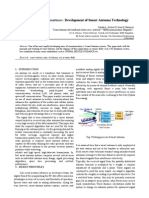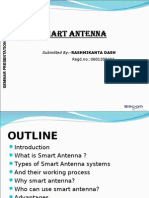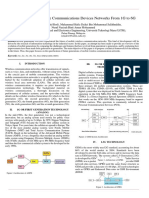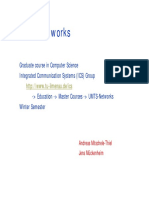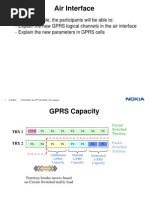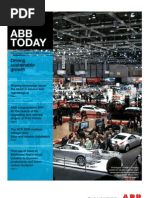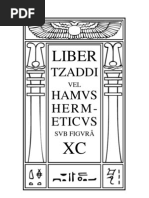MIMO Channel
MIMO Channel
Uploaded by
Daniel CadenaCopyright:
Available Formats
MIMO Channel
MIMO Channel
Uploaded by
Daniel CadenaOriginal Description:
Copyright
Available Formats
Share this document
Did you find this document useful?
Is this content inappropriate?
Copyright:
Available Formats
MIMO Channel
MIMO Channel
Uploaded by
Daniel CadenaCopyright:
Available Formats
International Journal of Computer Applications (0975 8887)
Volume 63 No.14, February 2013
Performance Analysis of MIMO Systems over
AWGN Channel with Antenna Selection using
Zero Forcing Receivers
Navjot Kaur
Lavish Kansal
Lovely Professional University
Phagwara, India
Lovely Professional University
Phagwara, India
ABSTRACT
High data rates within the limited radio frequency (RF)
spectrum is always desirable that leads to radios with
capabilities beyond a single-input single-output (SISO)
topology. Recently introduced wireless systems have adopted
multiple-input multiple-output (MIMO) topologies that use
two or more transmitters and two or more receivers to send
data simultaneously over the same RF bandwidth. The
performance of MIMO system can be improved by using
multiple antennas at transmitter and receiver so as to provide
spatial diversity. In this paper, the performance analysis of
MIMO system over AWGN fading channel with ZF receiver
is presented. The effects of the antenna selection can also be
analyzed from the simulated results. The BER (Bit Error Rate)
performance characteristics of Zero-Forcing (ZF) receiver is
investigated for M-PSK modulation technique over the
AWGN channel.
a single frequency band. In general, having multiple antennas
offers three potential use cases: diversity, beam forming, and
space division multiplexing (SDM). MIMO systems are
implemented to obtain a diversity gain to combat signal
fading.
An efficient implementation of space-time block coding
(STBC) for broadband wireless communications improves
the
performance
and
diversity
gains
of
a
space time (ST) coding system through a number of
parameters including type of trellis codes and channel
fading[3][4]. The two main functions of STC: diversity &
multiplexing. The maximum performance needs tradeoffs
between diversity and multiplexing. V-BLAST is a system in
which full spatial diversity is usually not achieved [5].
Keywords MIMO, AWGN, spatial diversity, BER, ZF,
M-PSK, SNR, multi-path fading, STBC.
1. INTRODUCTION
Multiple antennas employed at transmitter and receiver sides
are used in wireless communication so as to achieve the high
data rates through spatial multiplexing [1]. MIMO involves
multiple transmitters sending unique data content to multiple
receivers using spatial multiplexing. MIMO does increase
data rates and requires better SNR than an equivalent SISO
transmission. This method offers higher capacity to wireless
systems and the capacity increases linearly with the number of
antennas.
The block diagram of MIMO system is shown in the Fig. 1.1.
The basic main idea of MIMO is to improve BER or data rate
(bits/sec) by using multiple TX/RX antennas. [6]. For
achieving high data rate or improved BER, the core scheme
used in MIMO system is space-time coding (STC).
Future trends of wireless communications mentioned below
leads to MIMO development: Future wireless applications create insatiability as demand
for high data rate and high link quality wireless access
has increased a lot.
Spectrum has become a scarce and expensive resource as
bandwidth is very limited
Regulation, device and system capacity concerns as
transmit power is limited
Time and frequency domain processing are at limits, but
space is not!
MIMO provides higher capacity (bits/s/Hz), better
transmission quality (BER), increased coverage and improved
user position estimation due to the following factors:
Spatial multiplexing gain : Capacity gain at no additional
power or bandwidth consumption obtained through the use of
multiple antennas at both sides of a wireless radio link
Diversity gain : Improvement in link reliability obtained
by transmitting the same data on independently fading
branches
Array gain
Interference reduction
A MIMO system utilizes spatial diversity by using spatially
separated antennas in a dense multipath scattering
environment [2]. In MIMO, phased sets of antennas take
advantage of the differences in the spatial propagation paths
to improve signal robustness or to send multiple data sets over
In this paper, the effects of AWGN channel are considered on
the performance of MIMO systems with different antenna
selection using ZF receivers. AWGN channel is a universal
channel which adds a white Gaussian noise to the signal
Fig. 1.1: Block Diagram of 2X2 MIMO System
26
International Journal of Computer Applications (0975 8887)
Volume 63 No.14, February 2013
passing through it. It is a channel model used for analyzing
the various modulation schemes.
2. LITERATURE REVIEW
Multiple input-multiple output (MIMO) communication
systems employing coding techniques appropriate to multiple
antenna transmissions have recently been embraced as an
effective means to achieve high data rate over wireless
channels.
A. I. Sulyman [7] describes the impact of antenna selection on
the performance of multiple input-multiple output (MIMO)
systems over nonlinear communication channels. The author
has derived exact analytical expressions for evaluating the
PWEP performance of space-time trellis codes over nonlinear
MIMO channel.
C. Wang [8] explains the approach to increase the capacity of
MIMO systems by employing the spatial multiplexing where
independent information streams are transmitted from the
antennas. These information streams are then separated at the
receiver by means of appropriate signal processing techniques
such as maximum likelihood (ML) which achieves optimal
performance or linear receivers like Zero-Forcing (ZF) which
provide sub-optimal performance but it also offers significant
computational complexity reduction with
tolerable
performance degradation.
The comparison of MIMO with SISO technology was
discussed by S. G. Kim et. al [9]. MIMO can not only
improve spectral efficiency, but also enhance link throughput
or capacity of the system. The authors presented a tight closed
form BER approximation of MPSK for MIMO ZF receiver
over continuous flat fading channels. The larger the difference
between the number of transmit antennas and the number of
receive antennas is, the better performance is.
Equalizer and Minimum Mean Square Equalizers. Based on
the mathematical modeling and the simulation result it is
inferred that the ML equalizer is the best of the three
equalizers.
3. MODULATION TECHNIQUE
The digital communication system consists of two
fundamentals components i.e. modulation and encoder.
Modulation is the process of mapping the digital information
to analog form so it can be transmitted over a long distance
via channel. Modulator is a device used in transmitter side to
perform modulation and demodulation is done at the receiver
end by making use of demodulator. Demodulation is the
inverse process of modulation so as to recover the transmitted
digital information.
Phase-shift keying (M-PSK) for which the signal set is:
(1.1)
where Es the signal energy per symbol Ts is the symbol
duration and fc is the carrier frequency.
This phase of the carrier takes on one of the M possible
values.
(1.2)
M-ary PSK modulation yields a circular constellation as
shown in Fig. 1.2. The main constraint was to keep the
amplitude of the transmitted signals be constant.
A simple two-branch transmit diversity scheme was presented
by S. Alamouti [10]. The scheme uses two transmit antennas
and one receive antenna. It provides the same diversity order
as maximal-ratio receiver combining (MRRC) with one
transmit antenna, and two receive antennas.
V. Tarokh et.al [11] design a channel codes for improving the
high data rate and the reliability of communications over
fading channels using multiple transmit antennas. Data is
encoded by a channel code and the encoded data is split into
multiple streams that are simultaneously transmitted using
multiple transmit antennas. The received signal at each
receive antenna is a linear superposition of the multiple
transmitted signals perturbed by noise.
The performance analysis of the low-cost and effective
transmission strategy that employs the simple spatial
multiplexing at the transmitter and zero-forcing processing at
the receiver in multiuser MIMO scheduling systems was
discussed by C. Chen [12].
N. S. Kumar et. al [13], investigated about the three types of
equalizer for MIMO wireless receivers. The authors discussed
about a fixed antenna MIMO antenna configuration and
compare the performance with all the three types of equalizer
based receiver namely ZF, ML, and MMSE. BER
performance of ML Equalizer is superior than zero forcing
Fig. 1.2: Signal Constellation Diagram for 4-PSK
4. AWGN CHANNEL
AWGN channel is a channel that adds a white Gaussian noise
to the signal passing through it. This implies that the
channels amplitude frequency response is flat (thus with
unlimited or infinite bandwidth) and phase frequency
response is linear for all frequencies so that modulated signals
pass through it without any amplitude loss and phase
distortion of frequency components. Fading does not exist.
The only distortion is introduced by the AWGN.
The received signal is simplified to
(1.3)
where n(t) is the additive white Gaussian noise.
The whiteness of n(t) implies that it is a stationary random
process with a flat power spectral density (PSD) for all
frequencies. It is a convention to assume its PSD as
27
International Journal of Computer Applications (0975 8887)
Volume 63 No.14, February 2013
(1.4)
6. ZERO FORCING EQUALIZER
This implies that a white process has infinite power. This of
course is a mathematical idealization. According to the
Wiener-Khinchine theorem, the autocorrelation function of
the AWGN is
(1.5)
where ( ) is the Dirac delta function.
5. MIMO SYSTEM MODEL
Zero Forcing Equalizer is a linear equalization algorithm
which inverts the frequency response of the channel used in
communication systems.
The Zero-Forcing Equalizer applies the inverse of the channel
to the received signal, to restore the signal before the channel.
The name Zero Forcing corresponds to bringing down the ISI
to zero in a noise free case. This will be useful when ISI is
significant compared to noise [8] [9].
For a channel with frequency response F(f) the zero forcing
equalizer C(f) is constructed such that C(f) = 1 / F(f). Thus the
combination of channel and equalizer gives a flat frequency
response and linear phase F(f)C(f) = 1. By using the linear
model the received vector can be represented as:
y
(1.8)
For a 2x2 MIMO channel, the channel is modeled as,
Fig. 1.3: The MIMO Channel
(1.9)
The 2X2 MIMO channel is represented in Fig. 1.3 with an
antenna array with 2 elements at the transmitter and an
antenna array with 2 elements at the receiver is considered.
The input-output notation of the MIMO system can now be
expressed
by
the
equation:
(1.6)
where
denotes convolution, s(t) is a nt X 1 vector
corresponding to the nt transmitted signals, y(t) is a nr X 1
vector corresponding to the nr and u(t) is the additive white
noise.
7. SIMULATED RESULTS
In this section, BER (Bit Error Rate) analysis of MIMO
system over AWGN channel using STBC code structure is
done for M-PSK Modulation techniques. The BER analysis of
MIMO system is done for M-PSK over AWGN fading
channel where M can be 32, 64, 128, 256, 512 and 1024 for
different antenna configurations. Here receiving antennas
used are ranging from NR = 1 to NR = 4.
(A) M-PSK over AWGN Channel
The impulse response of the channel between the jth
transmitter element and the ith receiver element is denoted as
hij(,t). The MIMO channel can then be described by the nr X
nt H(,t) matrix:
SNR vs BER Plot of 32-PSK in AWGN Channel
10
No. of Rx
No. of Rx
No. of Rx
No. of Rx
=
=
=
=
1
2
3
4
-1
bit error rate
10
(1.7)
-2
10
The matrix elements are complex numbers that correspond to
the attenuation and phase shift that the wireless channel
introduces to the signal reaching the receiver with delay .
-3
10
10
15
20
signal to noise ratio
25
30
(a) 32-PSK
28
International Journal of Computer Applications (0975 8887)
Volume 63 No.14, February 2013
SNR vs BER Plot of 64-PSK in AWGN Channel
SNR vs BER Plot of 512-PSK in AWGN Channel
10
10
No.
No.
No.
No.
of Rx
of Rx
of Rx
of Rx
=
=
=
=
1
2
3
4
No. of Rx
No. of Rx
No. of Rx
No. of Rx
-1
=
=
=
=
1
2
3
4
-1
10
bit error rate
bit error rate
10
-2
10
-2
10
-3
10
10
15
20
signal to noise ratio
25
-3
10
30
10
(b) 64-PSK
30
40
signal to noise ratio
50
60
(e) 512-PSK
SNR vs BER Plot of 128-PSK in AWGN Channel
20
10
SNR vs BER Plot of 1024-PSK in AWGN Channel
No.
No.
No.
No.
of Rx
of Rx
of Rx
of Rx
=
=
=
=
10
1
2
3
4
No.
No.
No.
No.
-1
10
of Rx
of Rx
of Rx
of Rx
=
=
=
=
1
2
3
4
-1
bit error rate
bit error rate
10
-2
-2
10
10
-3
10
-3
10
20
30
40
signal to noise ratio
50
60
10
10
20
30
40
signal to noise ratio
50
60
(f) 1024-PSK
(c) 128-PSK
SNR vs BER Plot of 256-PSK in AWGN Channel
Fig. 1.4: SNR vs BER plots for M-PSK over
AWGN channel
10
No.
No.
No.
No.
of Rx
of Rx
of Rx
of Rx
=
=
=
=
1
2
3
4
In Fig. 1.4 (a) (f), SNR vs. BER plots for M-PSK over
AWGN channel for MIMO system with different antenna
configurations have been presented. From the graphs, it can
be concluded that as the number of receiving antennas are
increasing in the MIMO system, the BER keeps on decreasing
due to space diversity. Thus the system provides better BER
performance over the AWGN fading channel.
-1
bit error rate
10
-2
10
-3
10
10
20
30
40
signal to noise ratio
50
60
(d) 256-PSK
8. CONCLUSION
In this paper, the performance analysis of MIMO system over
AWGN fading channel employing different antenna
configurations is presented. It can be depicted from the graphs
that the BER keeps on decreasing in MIMO system due to
space diversity as increasing the number of receiving
antennas. Here receiving antennas have been used ranging
from NR = 1 to NR = 4. Spatial diversity techniques are
employed to improve signal quality and coverage. The
multiple receivers or multiple transmitters reduce multipath
fading and enhance SNR. Thus the proposed system provides
better BER performance.
29
International Journal of Computer Applications (0975 8887)
Volume 63 No.14, February 2013
9. REFERENCES
[1] R. W. Heath, Multimode antenna selection for spatial
multiplexing systems with linear receivers, IEEE
Transactions on Signal Processing, Vol. 53, Issue 8, pp.
3042-3056, 2005.
[8] C. Wang, On the Performance of the MIMO ZeroForcing Receiver in the Presence of Channel Estimation
Error, IEEE Transactions on Wireless Communications,
Vol. 6, Issue 3, pp. 805 810, 2007.
[2] E. Casas & C. Leung, Performance of OFDM/FM
scheme for data transmission over fading mobile radio
channels, 36th IEEE Vehicular Technology Conference,
Vol. 36, Issue 5, pp 103-108, 1986, Dallas, Texas.
[9] S. G. Kim, D. Yoon, Z. Xu & S. K. Park, Performance
Analysis of the MIMO Zero-Forcing Receiver over
Continuous Flat Fading Channels, IEEE Journal of
Selected Areas in Communications, Vol. 20, Issue 7, pp.
324 327, 2009.
[3] V. Tarokh, H. Jafarkhani & A. R. Calderbank, Space
time block codes from orthogonal designs, IEEE
Transactions on Information Theory, Vol. 45, Issue 5, pp.
14561467, 1999.
[10] S. Alamouti, A simple transmit diversity technique for
wireless communications, IEEE Journal on Selected
Areas of Communication, Vol. 16, Issue 8, pp. 1451
1458, 1998.
[4] G. Ganesan & P. Stoica. 2001. Space-time block codes:
a maximum SNR approach, IEEE Transactions on
Information Theory, Vol. 47, Issue 4, pp. 16501656,
2001.
[11] V. Tarokh, N. Seshadri & A. R. Calderbank, Space
Time Codes for High Data Rate Wireless
Communication: Performance Criterion and Code
Construction, IEEE Transactions on Information
Theory, Vol. 44, Issue 2, pp. 744-765, 1998.
[5] P. W. Wolniansky, G. J. Foschini, G. D. Golden & R. A.
Valenzuela, V-Blast: An architecture for realizing very
high data rates over the rich-scattering channel,
International Symposium on Signals, Systems and
Electronics, pp. 295300, 1998.
[12] C. Chen, Performance Analysis of Scheduling in
Multiuser MIMO Systems with Zero-Forcing Receivers,
IEEE Journal of Selected Areas in Communications, Vol.
25, Issue 7, pp. 14351445, 2007.
[6] X. Zhang, Z. Lv & W. Wang, Performance Analysis of
Multiuser Diversity in MIMO Systems with Antenna
Selection,
IEEE
Transactions
on
Wireless
Communications, Vol. 7, Issue 1, pp. 15-21, 2008.
[13] N. S. Kumar, G. J. Foschini, G. D. Golden & R. A.
Valenzuela, Bit Error Rate Performance Analysis of ZF,
ML and MMSE Equalizers for MIMO Wireless
Communication Receiver, European Journal of
Scientific Research, Vol. 59, Issue 4, pp. 522532, 2011.
[7] A. I. Sulyman, Performance of MIMO Systems With
Antenna Selection Over Nonlinear Fading Channels,
IEEE Journal of Selected Topics in Signal Processing,
Vol. 2, Issue 2, pp. 159-170, 2008.
30
You might also like
- Sports Writing ExercisesDocument2 pagesSports Writing ExercisesSaligan Dolf90% (69)
- Car Rental Business PlanDocument18 pagesCar Rental Business PlanShanoi Walker-Gayle100% (1)
- Umts Quick GuideDocument52 pagesUmts Quick GuideSreeram SNo ratings yet
- Radio Propagation and Adaptive Antennas for Wireless Communication Networks: Terrestrial, Atmospheric, and IonosphericFrom EverandRadio Propagation and Adaptive Antennas for Wireless Communication Networks: Terrestrial, Atmospheric, and IonosphericNo ratings yet
- Transitions from Digital Communications to Quantum Communications: Concepts and ProspectsFrom EverandTransitions from Digital Communications to Quantum Communications: Concepts and ProspectsNo ratings yet
- Definition and Overview of Smart AntennaDocument10 pagesDefinition and Overview of Smart Antennabhoop_sharmaNo ratings yet
- Adptive Antenna Array ParthDocument22 pagesAdptive Antenna Array ParthANkit JAinNo ratings yet
- Smart Antenna IeeeDocument4 pagesSmart Antenna Ieeervsharma02No ratings yet
- Mimo SystemDocument31 pagesMimo Systemhusseinelatar100% (1)
- 04 UMTS Architecture Ws11Document31 pages04 UMTS Architecture Ws11Kapil VatsalNo ratings yet
- Research On Smart AntennaDocument3 pagesResearch On Smart AntennaVictoryback BackNo ratings yet
- My Smart AntennaDocument20 pagesMy Smart AntennaRashmiKanta100% (1)
- The Evolution of Mobile Communications Devices Networks From 1G To 6G-Edited - 1Document5 pagesThe Evolution of Mobile Communications Devices Networks From 1G To 6G-Edited - 1Ahmad Zahin Mohd RosliNo ratings yet
- The Cellular Concept - System Design FundamentalsDocument54 pagesThe Cellular Concept - System Design FundamentalsHaresh VermaNo ratings yet
- EDGEDocument43 pagesEDGEPramod RaiNo ratings yet
- Name-Suvajit Mondal. Stream-E.C.E. Roll No.-3047. Semester-8 - Subject-3G PresentationDocument21 pagesName-Suvajit Mondal. Stream-E.C.E. Roll No.-3047. Semester-8 - Subject-3G PresentationSubir MaityNo ratings yet
- GSM Call Flow-RANDocument20 pagesGSM Call Flow-RANSagar Abhiwant100% (1)
- 5G - Massive MIMO - Why Massive MIMO ?: Spatial Focus With More AntennaDocument2 pages5G - Massive MIMO - Why Massive MIMO ?: Spatial Focus With More AntennaTry TestNo ratings yet
- HSPA Data Rates CalculationDocument15 pagesHSPA Data Rates CalculationJamal StevensNo ratings yet
- Radio Over Fiber TechnologyDocument46 pagesRadio Over Fiber TechnologySyed Shahzaib RazaNo ratings yet
- Digital Modulation TechniquesDocument34 pagesDigital Modulation TechniquesAkash ModiNo ratings yet
- GSM Signalling ProcedureDocument60 pagesGSM Signalling ProcedureSudheera IndrajithNo ratings yet
- GSM Fundamentals RFDocument65 pagesGSM Fundamentals RFPuneet YadavNo ratings yet
- Multiple-Input and Multiple-Output, MIMO: (Mee-Moh or My-Moh)Document34 pagesMultiple-Input and Multiple-Output, MIMO: (Mee-Moh or My-Moh)Azeem MaheenNo ratings yet
- Report of OfdmDocument60 pagesReport of OfdmAgnibha DasguptaNo ratings yet
- C7 SignallingDocument11 pagesC7 Signallingboss_bandorNo ratings yet
- Wireless Communication TechnologiesDocument10 pagesWireless Communication TechnologiesDino LigutanNo ratings yet
- Detail MIMO Wireless CommunicationsDocument4 pagesDetail MIMO Wireless Communicationsshakeel1900No ratings yet
- 4G DocumentationDocument13 pages4G DocumentationSwathi SwarnaNo ratings yet
- This LTE Tutorial Covers LTE Cell Search Procedure Used by UEDocument5 pagesThis LTE Tutorial Covers LTE Cell Search Procedure Used by UEPramod KumarNo ratings yet
- A Survey of Self-Interference Management Techniques For Single Frequency Full Duplex SystemsDocument27 pagesA Survey of Self-Interference Management Techniques For Single Frequency Full Duplex SystemsAndreea IonescuNo ratings yet
- Kathrein Street Connect: An In-Ground Antenna SolutionDocument26 pagesKathrein Street Connect: An In-Ground Antenna Solutioncyo3fffNo ratings yet
- Mimo: Future of Mobile Telecommunications Using Massive Mimo With 5G NetworksDocument18 pagesMimo: Future of Mobile Telecommunications Using Massive Mimo With 5G Networksqazi hussain shahNo ratings yet
- Click To Enter Your TitleDocument30 pagesClick To Enter Your TitleVani KrNo ratings yet
- 5G - Fifth-Generation ExplanationDocument5 pages5G - Fifth-Generation ExplanationSertse Dingle ShewandagnNo ratings yet
- 4g Wireless System FullDocument6 pages4g Wireless System Fullkalbande86No ratings yet
- Performance of Multiple-Input and Multiple-Output Orthogonal Frequency and Code Division Multiplexing Systems in Fading ChannelsDocument11 pagesPerformance of Multiple-Input and Multiple-Output Orthogonal Frequency and Code Division Multiplexing Systems in Fading ChannelsmsljyothiNo ratings yet
- Lte Ofdm, Ofdma and Sc-FdmaDocument5 pagesLte Ofdm, Ofdma and Sc-FdmaSamsher SinghNo ratings yet
- Security Architecture in UMTS Third Generation Cellular NetworksDocument20 pagesSecurity Architecture in UMTS Third Generation Cellular NetworksNitinNo ratings yet
- Millimeter Wave Mobile Communications For 5G CellularDocument15 pagesMillimeter Wave Mobile Communications For 5G CellularFrancesco GrassiNo ratings yet
- 01 UMTS Intro Ws10Document45 pages01 UMTS Intro Ws10alemayehu w. teferaNo ratings yet
- GprsDocument41 pagesGprsMohd JameelNo ratings yet
- 5G Massive MIMO Testbed - From Theory To Reality - National InstrumentsDocument11 pages5G Massive MIMO Testbed - From Theory To Reality - National InstrumentsxinlivuNo ratings yet
- Wireless Communication Over Wideband Channels Chuster PDFDocument386 pagesWireless Communication Over Wideband Channels Chuster PDFGokulraj PandiyanNo ratings yet
- Cellular Mobile CommDocument1 pageCellular Mobile CommDivonikaNo ratings yet
- Leveraging MIMO in Wide-Area NetworksDocument6 pagesLeveraging MIMO in Wide-Area NetworksVamsi KrishnaNo ratings yet
- GPRS Lecture 22Document21 pagesGPRS Lecture 22Puneet ManglaNo ratings yet
- The LabVIEW Simulation of Space-Time Coding Technique in The MIMO-OfDM SystemDocument6 pagesThe LabVIEW Simulation of Space-Time Coding Technique in The MIMO-OfDM Systemivy_publisherNo ratings yet
- Telecom IndustryDocument9 pagesTelecom Industrysmart telugu guruNo ratings yet
- InfoVista Planet 6.1 IoT LPWADocument36 pagesInfoVista Planet 6.1 IoT LPWAHassan Daud100% (1)
- BG 1Document1 pageBG 1bruck bogaleNo ratings yet
- TN 424 Lecture 2 PDFDocument24 pagesTN 424 Lecture 2 PDFJoakim NgatungaNo ratings yet
- A Review On OFDM: Concept, Scope & Its Applications: Manushree Bhardwaj, Arun Gangwar, Devendra SoniDocument5 pagesA Review On OFDM: Concept, Scope & Its Applications: Manushree Bhardwaj, Arun Gangwar, Devendra SonipankajmudgilNo ratings yet
- Device To Device (D2D)Document30 pagesDevice To Device (D2D)shibinps100% (1)
- MIMO SystemsDocument21 pagesMIMO SystemsAmira Hosny0% (1)
- RF Basics: Radio Propagatio: WirelessDocument3 pagesRF Basics: Radio Propagatio: WirelessMasood AhmedNo ratings yet
- 5G Channel CodingDocument5 pages5G Channel CodingBindia SahuNo ratings yet
- Rake ReceiverDocument5 pagesRake ReceiverShivendra VermaNo ratings yet
- Wireless Medium Access Control & CDMA Based CommunicationDocument9 pagesWireless Medium Access Control & CDMA Based CommunicationMahesh B RaghunandanNo ratings yet
- LTE Self-Organising Networks (SON): Network Management Automation for Operational EfficiencyFrom EverandLTE Self-Organising Networks (SON): Network Management Automation for Operational EfficiencySeppo HämäläinenNo ratings yet
- Fire Safety: Carlito RomeroDocument51 pagesFire Safety: Carlito RomeroSun TzuNo ratings yet
- Ikea TM - All Approved Ccos - Cco 01-131 - 17.05.2023Document258 pagesIkea TM - All Approved Ccos - Cco 01-131 - 17.05.2023Cosmin CarciumaruNo ratings yet
- " Internship Report ": The General Tyre and Rubber Company OF Pakistan LimitedDocument12 pages" Internship Report ": The General Tyre and Rubber Company OF Pakistan LimitedsaadNo ratings yet
- Modle Paper 02 Part 02Document4 pagesModle Paper 02 Part 02Muhammad AmmarNo ratings yet
- MA 103. Module 1Document2 pagesMA 103. Module 1SamanthA AmoguisNo ratings yet
- Laminated Composites - PDFDocument26 pagesLaminated Composites - PDFSPARSH KUMAR AGARWALNo ratings yet
- NCTB 2010 Class I English For TodayDocument63 pagesNCTB 2010 Class I English For TodaySenku Ishigami100% (1)
- Submarine Assurance Framework July 2021Document88 pagesSubmarine Assurance Framework July 2021cell bboyNo ratings yet
- Clostridium Tetani Bacteraemia: Case ReportDocument2 pagesClostridium Tetani Bacteraemia: Case ReportSandy TauvicNo ratings yet
- INT-FINDEL-D-TRV-002-01 - In2Track D2.1 Research Into Enhanced Tracks Switches and Structures PDFDocument191 pagesINT-FINDEL-D-TRV-002-01 - In2Track D2.1 Research Into Enhanced Tracks Switches and Structures PDFOm SinghNo ratings yet
- Answer Sheet PinocchioDocument1 pageAnswer Sheet PinocchioCriss BaleNo ratings yet
- ABB May2010 eDocument20 pagesABB May2010 ekhaizul813240No ratings yet
- SES ScrubberDocument3 pagesSES ScrubberChengkc2014No ratings yet
- CH 1Document17 pagesCH 1asodemse9694No ratings yet
- 11 LectureSlidesDocument158 pages11 LectureSlidesSpartinNo ratings yet
- Modul 1 IPStar ThaicomDocument33 pagesModul 1 IPStar ThaicomRinaldo AldoNo ratings yet
- Checklist For Physical Examination of KneeDocument13 pagesChecklist For Physical Examination of KneeGuruprasanth PazhamalaiNo ratings yet
- Microscope Buyers ChecklistDocument5 pagesMicroscope Buyers ChecklistTerence MichaelNo ratings yet
- TLE Mod6 MarketsFruitsandSeedling Version3Document55 pagesTLE Mod6 MarketsFruitsandSeedling Version3Normie Anne B. Jacinto100% (2)
- Liber TzaddiDocument6 pagesLiber TzaddiAarón Jamet OrgilésNo ratings yet
- Curriculum Vitae Jordi Vivaldi, August 2022Document7 pagesCurriculum Vitae Jordi Vivaldi, August 2022jordivivaldipieraNo ratings yet
- Cola LiquidDocument3 pagesCola LiquidmndmattNo ratings yet
- Axia Gear Up CatalogueDocument10 pagesAxia Gear Up CatalogueNurul ainNo ratings yet
- GWP AssignmentDocument36 pagesGWP AssignmentGkou DojkuNo ratings yet
- A - Inhaltsverzeichnis - R30IB Rev 9Document17 pagesA - Inhaltsverzeichnis - R30IB Rev 9Quí Lâm Nguyễn0% (1)
- Spanners and Sockets: Easy Mounting and Dismounting Without Nut DamageDocument8 pagesSpanners and Sockets: Easy Mounting and Dismounting Without Nut DamageFebriyantoNo ratings yet
- 1 Common Occupational Skills Notes STUDY UNIT 1 d137cb16371741fDocument29 pages1 Common Occupational Skills Notes STUDY UNIT 1 d137cb16371741fmpumeNo ratings yet
- Theory & Practice of Highway Design1Document237 pagesTheory & Practice of Highway Design1Suneth ThusharaNo ratings yet












